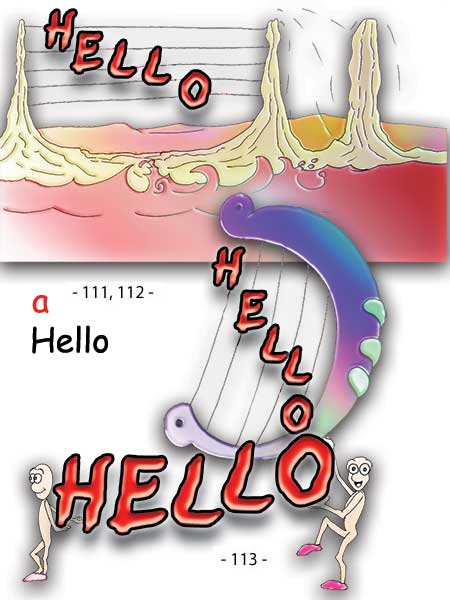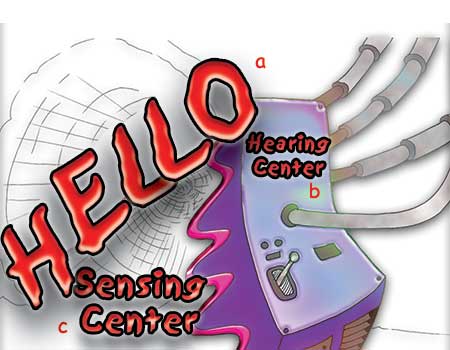32. What Happens at the Moment of Hearing?
When you run into friends in the street who call out, “Hello!” the sound waves they emit are collected by your ear. At sea level, sound travels through 6 meters (19 feet) of air in 1/50 second.
The air vibrating in both of your ears travels the short distance to your middle ear at great speed. The ear membrane, only 7.6 millimeters (0.2 inches) in diameter, begins vibrating, which vibrations are transmitted to three small bones that convert these sound vibrations into mechanical vibrations. The vibrations in these bones are then transmitted to the inner ear and the fluid inside a structure known as the cochlea, which resembles a snail (Figure 111).
Inside the cochlea, which contains fine strands of varying thicknesses, just like the strings of a harp (Figure 112), different tones are divided from one another. Your friend’s voice literally plays these strings. First the thickest strands vibrate, followed by the thinner ones. Finally, tens of thousands of rod-shaped bodies in the inner ear activate the hearing nerves through their own vibrations (Figure 113).
 |
| a. Hello |
| Figures 111 and 112: When friends say "Hello," the sound waves quickly reach your middle ear and cause the ear membrane to vibrate. This vibration is transmitted to three small bones. Their vibration is transmitted to the inner ear, where a special fluid inside the cochlea is set in motion. Inside the cochlea, there are fine threads of differing thicknesses just like the strings of a harp. Figure 113: The thickest strings vibrate first, followed by the thinner ones. Finally, tens of thousands of rod-shaped bodies in the inner ear transmit their own vibrations to the hearing nerves. The sound of your friends’ “Hello” is now only an electrical signal. |
nerves. At the end of this journey, a large portion of the millions of neurons in the brain are occupied with analyzing the hearing data thus obtained. Thus, finally, you actually hear your friends say “Hello” (Figure 114).
These processes, here described in greatly simplified terms, are in fact exceedingly complex and take place in less than a second. We see and hear hundreds of thousands of times every day, yet we generally never think how we do this. Everything we see and hear, we see and hear through the mercy of God, the Compassionate and Merciful. This should be a means whereby all believers give thanks.
In fact, God reveals in the Qur’an that human beings should reflect on this and be duly grateful:
God brought you out of your mothers’ wombs knowing nothing at all, and gave you hearing, sight and hearts so that perhaps you would show thanks. (Surat an-Nahl, 78)
 |
| a. Hello |
| Figure 114: The electrical signals reaching the brain are analyzed by neurons and perceived as sounds, thanks to which you are able to hear your friends greeting. |
- Introduction
- 1. Monitors That Control the Level of Fluids in the Blood
- 2. The Body's Impeccable Security System
- 3. Mother's Milk and the Hormone Oxytosin
- 4. Calcium Measurers
- 5. The Sugar Factory
- 6. Emergency Assistance The Hormone Adrenaline
- 7. The Lysosomal Enzymes That Purify the Body
- 8. The Flowless System That Regulates Blood Pressure
- 9. Growth Hormone
- 10. The Clock in Our Bodies That Never Goes Wrong
- 11. The Miraculous Molecule That Regulates Body Temperature
- 12. An Extraordinarily Delicate Balance
- 13. Hormones That Prepare the Way For the Baby -1
- 14. Hormones That Prepare the Way For the Baby -2
- 15. The Hormones in the Male Reproductive System
- 16. Other Properties of the Hormone Testosterone
- 17. Hemoglobin: The Miraculous Oxygen – Bearing Molecule
- 18. The Communications System in the Cell
- 19. The Messenger Hormone's Journey within the Cell
- 20. Communication Control in the Cell
- 21. Protein Traffic within the Cell
- 22. Chemical Communication in the Nerve Cell
- 23. Nitric Oxide: A Skilled Messenger
- 24. The Endothelial Cell: A Nitric Oxide Production Center
- 25. The Power Station in the Human Body
- 26. The
- 27. DNA Replication
- 28. Repair Enzymes
- 29. Protein Production
- 30. The Final Stage of Protein Production
- 31. The Cell Membrane and 100 Trillion Organized Workers
- 32. What Happens at the Moment of Hearing?
- 33. Blood Clotting
- 34. The Immune System
- 35. The Journey of Vitamin B12
- 36. The Pancreas: The Human Body's Chemist
- 37. Transporter Molecules in the Cell Membrane
- 37. Complement Proteins Responsible for Protecting the Body
- 39. Anti – Acid Formulas Producing Molecules
- 40. The Consciousness Displayed by Egg Cells
- Conclusion
